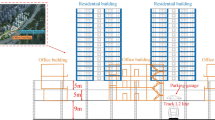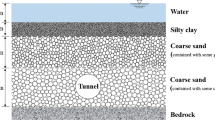Abstract
The impact of vibrations due to underground trains on Beijing metro line 15 on sensitive equipment in the Institute of Microelectronics of Tsinghua University was discussed to propose a viable solution to mitigate the vibrations. Using the state-of-the-art three-dimensional coupled periodic finite element-boundary element (FE-BE) method, the dynamic track-tunnel-soil interaction model for metro line 15 was used to predict vibrations in the free field at a train speed of 80 km/h. Three types of tracks (direct fixation fasteners, floating slab track and floating ladder track) on the Beijing metro network were considered in the model. For each track, the acceleration response in the free field was obtained. The numerical results show that the influence of vibrations from underground trains on sensitive equipment depends on the track types. At frequencies above 10 Hz, the floating slab track with a natural frequency of 7 Hz can be effective to attenuate the vibrations.
Similar content being viewed by others
References
NELSON J T. Recent developments in ground-borne noise and vibration control [J]. Journal of Sound and Vibration, 1996, 193(1): 367–376.
WOLF S. Potential low frequency ground vibration (<6.3 Hz) impacts from underground LRT operations [J]. Journal of Sound and Vibration, 2003, 267(3): 651–661.
LIU Wei-ning, DING De-yun, SUN Xiao-jing, LIU Wei-feng. Study on special vibration reduction measures in Beijing metro line 4 [R]. Beijing: Beijing Jiaotong University, 2005: 1–10. (in Chinese)
LIU W F, GUPTA S, DEGRANDE G, LIU W N. Numerical modelling of vibrations induced by underground railway traffic on metro line 4 in Beijing [R]. Leuven: K.U. Leuven and Beijing Jiaotong University, 2006: 12–14.
GUPTA S, LIU W F, DEGRANDE G, LOMBAERT G, LIU W N. Prediction of vibrations induced by underground railway traffic in Beijing [J]. Journal of Sound and Vibration, 2008, 310(1): 608–630.
DING D Y, GUPTA S, LOMBAERT G, LIU W N, DEGRANDE G. The prediction of vibrations induced by underground railway traffic on line 8 of Beijing metro [R]. Leuven: K.U.Leuven and Beijing Jiaotong University, 2008: 13–15.
CHUA K H, BALENDRA T, LO K W. Groundborne vibrations due to trains in tunnels [J]. Earthquake Engineering and Structural Dynamics, 1992, 21(5): 445–460.
JONES C J C, THOMPSON D J, PETYT M. A model for ground vibration from railway tunnels [J]. Proceedings of the ICE — Transport, 2002, 153(2): 121–129.
LIN Q H, KRYLOV V V. Effect of tunnel diameter on ground vibrations generated by underground trains [J]. Low Frequency Noise, Vibration and Active Control, 2000, 19(11): 17–25.
von ESTORFF O, STAMOS A A, BESKOS D E, ANTES H. Dynamic interaction effects in underground railway traffic systems [J]. Engineering Analysis with Boundary Elements, 1991, 8(4): 167–175
SHENG X, JONES C J C, PETYT M. Ground vibration generated by a harmonic load acting on a railway track [J]. Journal of Sound and Vibration, 1999, 225(1): 3–28.
LOMBAERT G, DEGRANDE G, CLOUTEAU D. Numerical modelling of free field traffic induced vibrations [J]. Soil Dynamics and Earthquake Engineering, 2000, 19(7): 473–488.
HANAZATO T, UGAI K, MORI M, SAKAGUCHI R. Three-dimensional analysis of traffic induced ground vibrations [J]. Journal of Geotechnical Engineering, 1991, 117(8): 1133–1151.
MOHAMMADI M, KARABALIS D L. Dynamic 3-D soil-railway track interaction by BEM-FEM [J]. Earthquake Engineering and Structural Dynamics, 1995, 24(9): 1177–1193.
FORREST J A, HUNT H E M. A three-dimensional tunnel model for calculation of train-induced ground vibration [J]. Journal of Sound and Vibration, 2006, 294(4/5): 678–705.
HUSSEIN M F M, HUNT H E M. A numerical model for calculating vibration from a railway tunnel embedded in a full-space [J]. Journal of Sound and Vibration, 2007, 305(3): 401–431.
GARDIEN W, STUIT H G. Modelling of soil vibrations from railway tunnels [J]. Journal of Sound and Vibration, 2003, 267(3): 605–619.
CLOUTEAU D, ARNST M, AL-HUSSAINI T M, DEGRANDE G. Free field vibrations due to dynamic loading on a tunnel embedded in a stratified medium [J]. Journal of Sound and Vibration, 2005, 283(1/2): 173–199.
DEGRANDE G, CLOUTEAU D, OTHMAN R, ARNST M, CHEBLI H, KLEIN R, CHATTERJEE P, JANSSENS B. A numerical model for ground-borne vibrations from underground railway traffic based on a periodic finite element-boundary element formulation [J]. Journal of Sound and Vibration, 2006, 293(3/5): 645–666.
GUPTA S. Numerical modelling of subway induced vibrations [D]. Leuven: Department of Civil Engineering, K.U.Leuven, 2008: 24–76.
CHEBLI H, OTHMAN R, CLOUTEAU D. Response of periodic structures due to moving loads [J]. Comptes Rendus Mécanique, 2006, 334(6): 347–352.
LOMBAERT G, DEGRANDE G, KOGUT J, FRANÇOIS S. The experimental validation of a numerical model for the prediction of railway induced vibrations [J]. Journal of Sound and Vibration, 2006, 297(3/5): 512–535.
LOMBAERT G, DEGRANDE G. Ground-borne vibration due to static and dynamic axle loads of intercity and high-speed trains [J]. Journal of Sound and Vibration, 2009, 319(3/5): 1036–1066.
LIU Wei-feng. Study on numerical prediction model of metro train induced vibrations in tunnels and free field [D]. Beijing: eijing Jiaotong University, 2010: 90–108. (in Chinese)
HAMID A, YANG T L. Analytical description of track-geometry variations [J]. Transportation Research Record, 1982, 838: 19–26.
CLOUTEAU D, ELHABRE M L, AUBRY D. Periodic BEM and FEM-BEM coupling: Application to seismic behaviour of very long structures [J]. Computational Mechanics, 2000, 25(6): 567–577.
BAMPTON M C C, CRAIG R R Jr. Coupling of substructures for dynamic analyses [J]. Journal of Aircraft Industries Association of America, 1968, 6(7): 1313–1319.
WILSON G P, SAURENMAN H J, NELSON J T. Control of ground-borne noise and vibration [J]. Journal of Sound and Vibration, 1983, 87(2): 339–350.
LOMBAERT G, DEGRANDE G, VANHAUWERE B, VANDEBORGHT B, FRANÇOIS S. The control of ground-borne vibrations from railway traffic by means of continuous floating slabs [J]. Journal of Sound and Vibration, 2006, 297(3/5): 946–961.
KUO C M, HUANG C H, CHEN Y Y. Vibration characteristics of floating slab track [J]. Journal of Sound and Vibration, 2008, 317(3/5): 1017–1034.
XIANG Jun, WANG Yang, HE Dan, KONG Fan-bing, GUO Gao-jie. Model of vertical vibration of train and floating slab track system in urban rail transit system [J]. Journal of Central South University: Science and Technology, 2008, 39(3): 596–601. (in Chinese)
DING De-yun, LIU Wei-ning, ZHANG Bao-cai, SUN Xiao-jing. Modal analysis on the floating slab track [J]. Journal of the China Railway Society, 2008, 30(3): 61–64. (in Chinese)
DING De-yun, LIU Wei-ning, ZHANG Bao-cai, XIE Da-wen. 3-D numerical study on vibration isolation performance of special floating slab track in lab [J]. Journal of the China Railway Society, 2009, 31(6): 58–62. (in Chinese)
OKUDA H, ASANUMA K, MATSUMOTO N, WAKUI H. Dynamic load, resistance and environmental performance of floating ladder track [J]. Quarterly Report of RTRI, 2004, 45(3): 149–155.
HOSKING R J, MILINAZZO F. Floating ladder track response to a steadily moving load [J]. Mathematical Methods in the Applied Sciences, 2007, 30(14): 1823–1841.
XIA H, DENG Y S, ZOU Y W, de ROECK G, DEGRANDE G. Dynamic analysis of rail transit elevated bridge with ladder track [J]. Frontiers of Architecture and Civil Engineering in China, 2009, 3(1): 2–8.
Author information
Authors and Affiliations
Corresponding author
Additional information
Foundation item: Projects(50538010, 50848046) supported by the National Natural Science Foundation of China; Project(BIL07/07) supported by the Research Council of K.U.Leuven and the National Natural Science Foundation of China
Rights and permissions
About this article
Cite this article
Ding, Dy., Liu, Wn., Gupta, S. et al. Prediction of vibrations from underground trains on Beijing metro line 15. J. Cent. South Univ. Technol. 17, 1109–1118 (2010). https://doi.org/10.1007/s11771-010-0604-3
Received:
Accepted:
Published:
Issue Date:
DOI: https://doi.org/10.1007/s11771-010-0604-3




